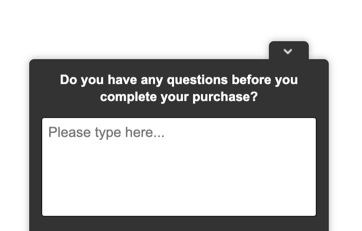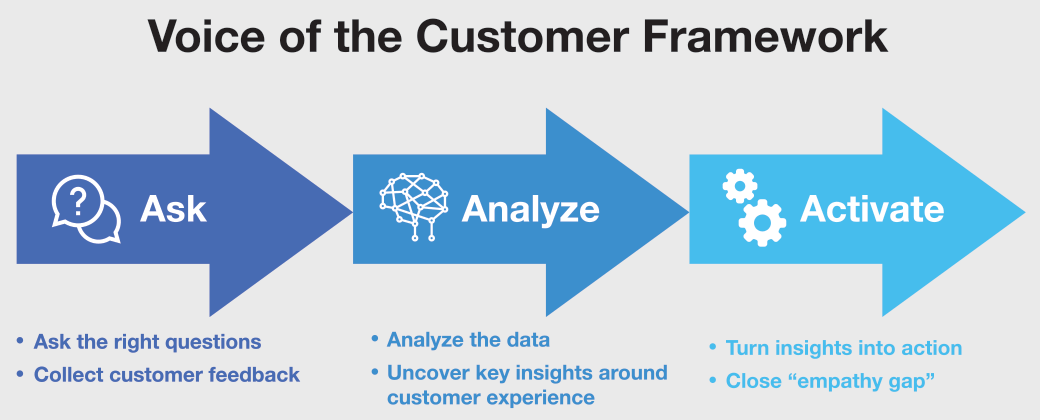Analytics Blog

Activate Powerful Customer Insights with Voice of the Customer
As businesses head into 2020, improving the customer experience is quickly becoming a top priority. According to the 2019-2020 Top Insights for the C-Suite report by Gartner, 53 percent of marketers cited enhancing the customer experience as a top driver for innovation.
Today, many organizations are heavily invested in collecting quantitative data with analytics platforms, close-ended surveys, and polls to inform their strategies and make “data-driven” decisions. While these sources of data are invaluable for understanding who customers are, what they’re doing, and where they’re encountering friction, they do little to uncover the “whys” behind customer behavior.
The end result? Many businesses are missing the mark entirely, losing sight of the human element of customer experience. This creates a growing “empathy gap” between organizations and their customers, with 68 percent of consumers saying brands don’t make them feel like an individual.
To stand out among your largest competitors and thrive, your organization must create a customer experience that is truly extraordinary. But how do you create an experience that’s sure to resonate with and delight customers?
“Get closer than ever to your customers. So close that you tell them what they need well before they realize it themselves.” — Steve Jobs
To bridge the empathy gap that exists, your business must understand your customers’ most compelling problems and how to communicate your solutions in a language that resonates with them. Business leaders must lead with a customer-centric strategy, and Voice of the Customer (VoC) is a framework that should play an integral part in developing that strategy.
What is Voice of the Customer (VoC)?
Simply put, Voice of the Customer (VoC) is a methodology for gaining a better understanding of your customers’ needs and expectations. Your organization will be able to collect the thoughts your customers have, the emotions they feel, and friction points they encounter. When your teams curate this information about your customers and begin to put it into action, they’ll craft more powerful marketing messaging that resonates with customers. Your organization will also be well-equipped to develop more attractive products and services that solve your customers’ most pressing problems.
Now, it’s important to know that VoC isn’t a one-time engagement; rather, it’s a continuous process for capturing and analyzing data about your customers. As a result of these efforts, your organization will gain an “outside-in” perspective. This enables a view of your brand as your customers truly see it and experience it.
Techniques for Capturing the Voice of the Customer
Today, an abundance of tools and techniques exist for collecting customer feedback, all of which can fuel your organization’s efforts in improving the customer experience. There are several effective ways that this data can be collected, some of which are highlighted below.
Customer Surveys
Customer surveys are easy to create, and they are reliable at revealing the strengths and weaknesses of your business. Surveys can be built to collect responses with any combination of true/false, yes/no, multiple choice, and open-ended questions. Once created, these surveys can be sent via email or, alternatively, responses can be captured directly from your website.
The benefits of using customer surveys are numerous:
- Your organization can measure how your product, service, and overall experience meets, exceeds, or falls short of your customers’ expectations.
- Surveys can inform strategy across teams and help prioritize areas of focus for customer experience improvements.
- Survey responses can be used to identify new areas for innovation or expansion.
- Responses can be collected at scale by inviting hundreds or even thousands of participants.
Your organization can collect feedback using one of the many survey software-as-a-service platforms available today. These platforms often offer the ability to create surveys with any number or combination of questions, whether open-ended or canned. Another added benefit of these platforms is that many offer a repository of pre-made questions written by experts. However, it’s still important to come up with a strategy for the specific questions that should be asked and where they should be asked.
While there are many customer survey tools available these days, Google Surveys and Qualtrics are popular choices with organizations. Both tools offer compelling benefits that span a number of different use cases.
Google Surveys allows your team to tap into Google’s expansive network reach for deep market research about consumers around the world. Google Surveys boasts an intuitive interface and tools that allow for seamless survey creation, with the ability to screen candidates with qualifier questions.
On the other hand, Qualtrics is a fully-featured suite of customer experience tools, including a powerful survey builder with hundreds of question types, pre-built survey templates, statistical analysis, and a number of third-party integrations. Moreover, for government agencies that have strict privacy and security requirements, Qualtrics offers a dedicated solution to meet your team’s needs with its Experience Management Platform.
Survey Metrics Your Organization Can Track
While many surveys capture feedback through open-ended questions, there are several metrics that can help your organization keep tabs on customer satisfaction. Of these, there are two in particular that are crucial for tracking the customer experience and overall satisfaction with your brand, your products, and your services.
Net Promoter Score (NPS)
Net Promoter Score (NPS) is an index from -100 to 100 that measures your customers’ loyalty and willingness to recommend your products and services to others.
Survey participants are asked a question such as “How likely is it that you would recommend [Your Company/Your Product/Your Service] to a friend or colleague?” The participants can then give a rating between 0 (not likely) and 10 (very likely).
Depending on the response, customers are placed into one of three groups:
- Promoters give a rating of 9 or 10. This group is loyal, extremely satisfied and very likely to share their experience and advocate for your brand, product or service.
- Passives give a rating of 7 or 8. They’re generally content customers, but not enough to share their experiences with others.
- Detractors give a rating between 0 and 6. This group of customers is dissatisfied and very unlikely to purchase again. In some cases, they may even share their negative experience with others.
Ultimately, the NPS score helps you to identify strengths, weaknesses, growth opportunities, and how loyal your customers are. More importantly, it helps your organization monitor customer loyalty over time. If your NPS score drops drastically, for example, this should prompt a deeper analysis on potential problem areas that can be improved upon. Keeping a constant eye on your NPS score will help to ensure that you act upon these insights in a timely manner.
Customer Satisfaction (CSAT)
Like NPS, Customer Satisfaction (CSAT) is another metric used to measure the customer experience. It differs from NPS in that CSAT measures your customers’ levels of satisfaction with your core products and services, while NPS is focused more on customer loyalty to your business.
Survey participants are generally asked to rate their overall satisfaction with a particular product or service they received on a scale of 1 to 5, with 1 being “Very Unsatisfied” and 5 being “Very Satisfied.”
The formula for calculating CSAT is:
![]() (Number of satisfied customers with a score of 4 and 5) / Total number of survey responses) x 100 = Total % of satisfied customers
(Number of satisfied customers with a score of 4 and 5) / Total number of survey responses) x 100 = Total % of satisfied customers
CSAT is a transactional metric, so it’s best served after a transaction has been completed. Here are a few common use cases for CSAT:
- After a customer purchases a product or service
- At the end of a customer service phone call
- Prior to a customer’s subscription renewal
- After a user engages with or uses a new feature of your website or software
The key benefit here is that your team receives real-time feedback with CSAT, which enables them to quickly respond to and make changes based upon negative feedback.
Website Feedback Polls
Feedback polls can be added directly to your website to gather both qualitative and quantitative data about users that are browsing. Many of these tools offer a number of closed and open-ended question types, specific targeting capabilities, and analytics/reporting dashboards for viewing responses. These polls can also be served to users in a very unobtrusive way so that it doesn’t interrupt their browsing experience.
Feedback polls can also be designed to allow users to provide their contact information upon completion. This a huge advantage for businesses because customer service can “close the loop” and respond to users directly for additional feedback or problem resolution. Organizations that are leaders in VoC recognize the value of closing the feedback loop — so much so that they have incorporated it into their optimization roadmaps. Even if your team isn’t equipped and able to do this in the short term, we recommend thinking about how having this capability will help you evolve your customer-centric strategy in the long term.

Social Listening
Customers congregate on many social media platforms that exist today to share their experiences, both good and bad. Time is of the essence with this channel, because when bad feedback is received, it can gain lots of attention. Luckily, you can act on and manage this feedback efficiently with social listening tools.
Social listening tools offer social monitoring, keeping track of brand conversations and mentions across your social media accounts. They enable you to aggregate, analyze, and act on these responses proactively.
Hootsuite and Sprout Social are two very popular all-in-one social media management suites that offer social listening as a part of their core offerings. With both, your teams can find social media conversations and filter them by keyword, hashtag, and location. Additionally, your teams will be able to publish content, engage with users, and measure social media performance.

How Voice of the Customer Helps Your Brand
The benefits of Voice of Customer are incredibly valuable to an organization that desires continued growth and success.
VoC can help your business:
- Strengthen customer loyalty to your brand
- Develop more effective products and services that solve real customer needs
- Identify actionable steps you can take to improve the customer experience
- Discover new and compelling product or service ideas
- Drive positive impact on key performance indicators (KPIs) that matter, such as revenue and profit
If your organization wishes to reap these benefits, VoC must be approached strategically, or else decisions may be made on limited data and false assumptions about your customers.
Where Organizations Tend to Go Wrong
Despite the power of this methodology, a number of businesses struggle to obtain any real value from it. Here’s where most tend to fall short when trying to implement Voice of the Customer:
Problem #1: They ask the wrong questions.
It’s easier than ever to gather customer feedback with the abundance of tools available today, but it won’t serve your business well if you’re asking the wrong questions. If your teams are asking leading questions, they’ll only guide respondents towards the answers they want to hear. The end result is that your teams will have a difficult time drawing any insights on the real problems customers are facing. Asking close-ended questions can also leave you with little to act on because, while these questions may reveal how a customer feels, you’ll never discover why they feel that way.
Now, as important as it is to ask the right questions, timing will make or break your efforts to collect responses. If you ask for users to participate in a survey while they are in the midst of their shopping experience, you’ll surely frustrate them. In some cases, they may decide to leave and shop elsewhere.

(Note: the screenshot above is an example of a customer survey gone wrong)
Problem #2: Their efforts are siloed.
As organizations grow and departments across the organization make greater efforts to gather feedback about customers, feedback silos can emerge. In turn, this can cloud your organization’s view of the customer experience and hamper your abilities to succeed.
Here are a few signals that customer experience silos are taking root in your business:
- Decision makers have limited (or no) knowledge of major projects or initiatives prioritized (or in progress) from department to department
- A lack of information sharing, collaboration, and ownership across departments, especially when it comes to handing off customers across products, services, and departments
- Seamless directives and communication from the top-down, but little to no bottom-up communication
- A lack of a common vision and goals across the organization
- Vastly different customer experiences across channels or platforms
Problem #3: They fight back against customer feedback.
When you’re passionate about connecting with customers and find that your efforts have failed to resonate with them for so long, it’s hard not to be disappointed. Oftentimes, this can lead organizations to believe that their customers are wrong, but this is a deadly mistake. Dismissing customer feedback will only push you further away from your customers and devalue your brand.
When your entire organization makes the right effort to collect real customer feedback, the findings can be shocking and uncomfortable. This is a good thing, however, as it brings to light the underlying issues your customers are facing, and it exposes budding areas for improving the customer experience.
The good news is that these problems can be avoided altogether. How can you ensure your VoC efforts aren’t wasted? The answer lies in proper preparation.
How to Prepare for Success with Voice of the Customer
Simply incorporating VoC tools and collecting feedback isn’t enough. Your business needs to plan for success, communicate findings across teams, and take action on the problems uncovered. To reach success, structure, and organization must be maintained throughout the process. Here’s how your business can implement a proper framework for Voice of the Customer and realize success.
Anatomy of a Successful Voice of the Customer Program
At Blast, we help organizations execute a voice of customer framework of “ask, analyze, and activate.” The process starts with setting up a strategy for collecting customer feedback and the right questions your teams should ask your customers. Then, our consultants leverage their expertise to analyze the data and uncover key insights around the customer experience. Finally, we partner with your team to realize the value of your VoC program. We help you turn those insights into actions that close that “empathy gap” and EVOLVE the customer experience. Since customer expectations tend to change over time, we continue to collaborate with and support your organization at every step of the way.

Get Buy-In from Leadership
Business leaders need to foster a culture that welcomes feedback, whether positive or negative. It goes beyond simply stating that the organization needs to listen to customer feedback. Leaders must commit to this on an ongoing basis, and they must ensure that these learnings permeate the organization.
CASE STUDY: How Shocking Insights Led to an Improved Customer Experience (CX)
A large appliance retailer approached us to improve their customer experience (CX) and wanted to know more about how visitors were engaging across the funnel.
After conducting a thorough customer experience audit, we recommended launching a feedback poll on their Product Listing Pages (PLP) to better understand customers’ preferences for viewing products of interest. At that time, the default view displayed the lowest price available, regardless of the location of the appliance.
The retailer firmly believed that showing the lowest price was what their customers truly wanted. However, feedback poll responses indicated otherwise. More than 76% of customers stated that they preferred proximity to their location over lower costs.
Leadership on the team, although shocked by the feedback, didn’t disregard the findings. They partnered with our team on how they could take action on this new insight. We provided them actionable CX recommendations to improve their PLP experience, which included making several updates to product sorting. The new product sort clearly showed products local to customers.
A follow-up feedback poll was targeted to the new PLP experience, which revealed that it met visitor expectations, improved clarity around pricing and, ultimately, contributed to more than a 16% increase in Visit-to-Order rate.
View more details in the full Voice of Customer case study.
Get Started with Voice of the Customer Today
If you want to stay ahead of your competitors and desire continued growth, your organization must get into the heads and hearts of your customers. The Voice of the Customer methodology will help to accomplish that and more. Throughout the process, you’ll uncover who your customers are, how they perceive your brand, what attracts them to (or turns them off of) your product offerings, where they encounter pain or points of friction, and how they communicate all of this. In using these findings, your organization will build more attractive products that solve your customers’ biggest problems. Better yet, you’ll ensure that they keep coming back for more.
If you’re ready to build a customer experience that’s truly remarkable and closes that “empathy gap,” partner with our experts at Blast Analytics. We’ll help your business leaders build the foundation for a successful VoC program and guide you every step of the way. For more information on getting started, visit our Voice of the Customer Quick Start Guide.








